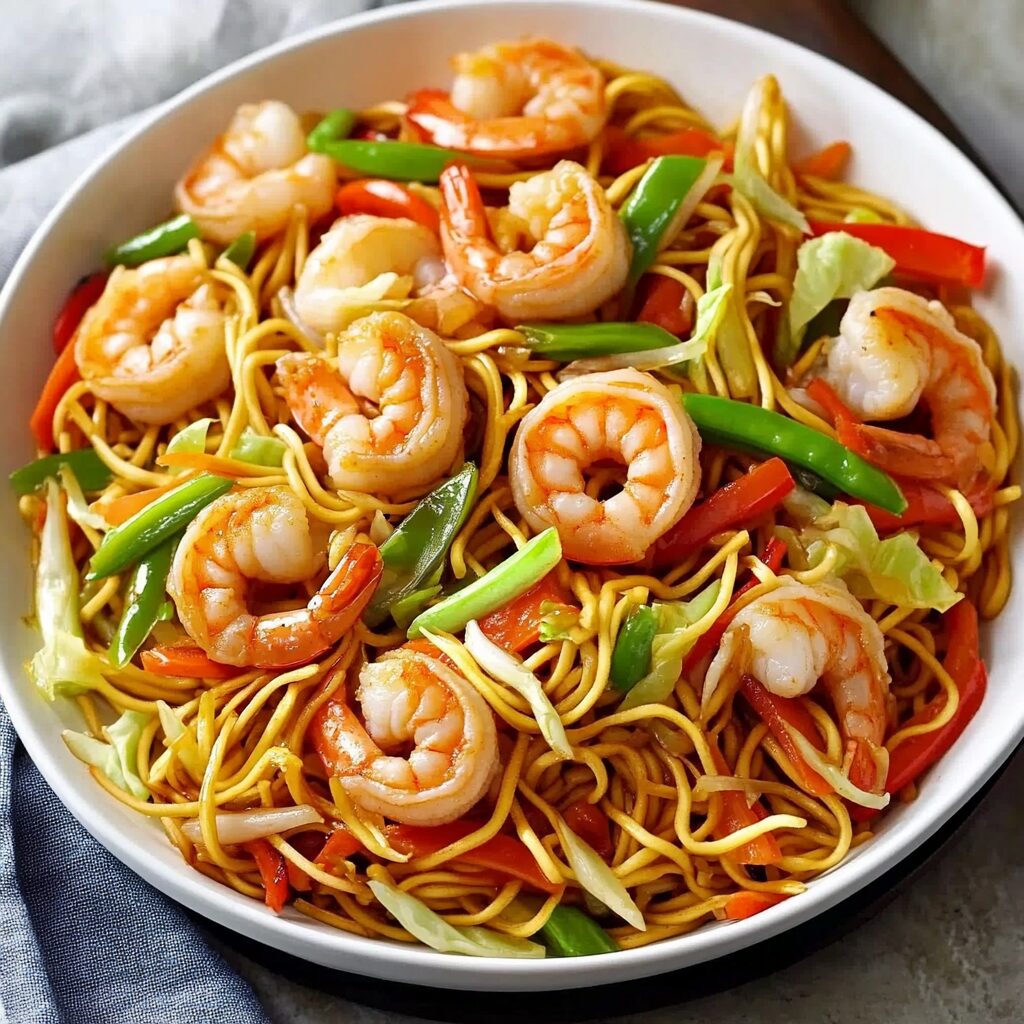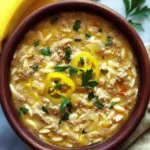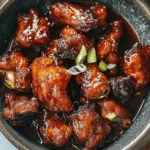This Shrimp Chow Mein is a delightful fusion of tender shrimp, crisp vegetables, and perfectly cooked noodles, all tossed together in a savory sauce. The combination of flavors and textures makes it a standout dish that’s both satisfying and nutritious.
Ideal for a weeknight dinner or a special occasion, this recipe brings the taste of authentic Chinese cuisine to your table. The balance of protein, fiber, and carbohydrates ensures a wholesome meal that doesn’t compromise on taste. Plus, it’s quick and easy to prepare, making it a go-to choice for busy evenings.
Full Recipe
Ingredients:
-
1 lb uncooked shrimp (31–40 per pound), peeled and deveined
-
3 tablespoons reduced-sodium soy sauce, divided
-
4 teaspoons Shaoxing wine or dry sherry, divided
-
1 tablespoon cornstarch
-
1/4 teaspoon white pepper
-
6 oz uncooked chow mein noodles
-
3 tablespoons canola oil, divided
-
3 garlic cloves, minced
-
1 teaspoon minced fresh gingerroot
-
3 cups shredded cabbage
-
1 large sweet red pepper, chopped
-
1 cup bean sprouts
-
1/2 cup shredded carrots
-
10 green onions, cut into 2-inch pieces
Directions:
-
In a small bowl, whisk together 1 tablespoon soy sauce, 2 teaspoons Shaoxing wine, cornstarch, and white pepper. Add shrimp and toss to coat; set aside.
-
In another small bowl, whisk together the remaining 2 tablespoons soy sauce, 2 teaspoons Shaoxing wine, oyster sauce, and sugar. Set aside.
-
Cook chow mein noodles according to package directions. Drain and set aside.
-
Heat 1 tablespoon oil in a large nonstick skillet or wok over medium-high heat. Add shrimp and cook until pink, 3–4 minutes. Remove with a slotted spoon; keep warm.
-
Add remaining 2 tablespoons oil to the pan. Add garlic and ginger; cook and stir for 1 minute. Add cabbage, red pepper, bean sprouts, and carrots; cook until crisp-tender, about 2–3 minutes.
-
Add cooked noodles, reserved shrimp, sauce mixture, and green onions to the pan. Toss to combine and heat through. Serve immediately.
Prep Time: 15 minutes | Cooking Time: 15 minutes | Total Time: 30 minutes
Kcal: 350 kcal | Servings: 4 servings
A Deep Dive into Shrimp Chow Mein: Flavor, Culture, and Cooking Secrets
Shrimp Chow Mein is more than just a quick weeknight dinner—it’s a beloved classic that spans continents, cultures, and cuisines. Whether you find it in a takeout box, a sizzling street food stall, or served in a refined Chinese restaurant, its distinctive blend of savory noodles, succulent shrimp, and crisp vegetables makes it irresistible.
Let’s explore everything there is to know about Shrimp Chow Mein—from its fascinating origins to modern preparation tips, flavor variations, nutritional value, and the reasons why this dish has become a staple in kitchens across the globe.
The Cultural Roots of Chow Mein
“Chow Mein” originates from the Taishanese dialect of Chinese, where “chow” means “to stir-fry” and “mein” means “noodles.” This simple phrase has traveled across oceans and generations, embedding itself in various regional cuisines from Hong Kong to San Francisco.
Chow Mein was popularized in America in the early 20th century by Chinese immigrants who adapted their cooking to local ingredients and palates. Over time, dishes like Shrimp Chow Mein were developed to appeal to a wider audience, maintaining core Chinese techniques while blending with Western tastes.
Shrimp Chow Mein reflects the elegance of Chinese culinary traditions—where balance is key. Each bite combines the briny sweetness of shrimp, the umami depth of soy-based sauces, and the satisfying chew of noodles. The dish honors its heritage while inviting innovation.
Why Shrimp? The Ideal Protein for Chow Mein
Shrimp is an ideal choice for stir-fry dishes for several reasons. It cooks quickly, making it perfect for high-heat, short-cook methods like wok-frying. It also adds a touch of indulgence, transforming a humble noodle stir-fry into a dish that feels both special and comforting.
Nutritionally, shrimp is high in protein and low in fat, offering a lean alternative to beef or pork. Its slightly sweet flavor pairs beautifully with the savory, garlicky base of Chow Mein, creating a delightful contrast that elevates the whole dish.
Additionally, shrimp absorbs flavors incredibly well. Marinating it in a blend of soy sauce, wine, or sesame oil allows it to carry the essence of the sauce into each tender bite.
Noodles: The Heart of the Dish
The type of noodles used in Chow Mein defines the character of the dish. Traditionally, Chow Mein noodles are egg noodles that are either boiled and then stir-fried (for a soft version) or pan-fried until crispy (for a crunchy version). The recipe can be adapted to both styles, depending on regional preferences or personal taste.
For the crispy version, noodles are fried until golden, forming a crunchy nest that cradles the shrimp and vegetables on top. In the soft version, the noodles are tossed directly with the other ingredients, absorbing the sauce and melding the flavors beautifully.
In both cases, the noodles play a starring role—not just a base, but an integral part of the overall flavor and texture profile.
Vegetables and Aromatics: Building Flavor and Texture
While the shrimp and noodles are the main attraction, the vegetables bring color, nutrition, and a satisfying crunch. Cabbage, bell peppers, carrots, bean sprouts, and scallions are commonly used in Shrimp Chow Mein. These vegetables are stir-fried quickly to retain their crispness and vibrant color.
Garlic and ginger serve as the aromatic backbone of the dish, awakening the senses the moment they hit the hot oil. These elements don’t just season the dish—they infuse it with a signature warmth and depth that’s instantly recognizable in Chinese cooking.
The combination of textures—tender shrimp, chewy noodles, and crisp vegetables—creates a dynamic eating experience in every mouthful.
The Sauce: A Perfect Balance of Savory and Sweet
The soul of Shrimp Chow Mein lies in its sauce. A balanced sauce is typically a blend of soy sauce, oyster sauce, Shaoxing wine, and sometimes a touch of sugar. This mixture creates a savory, slightly sweet, umami-rich glaze that coats every component of the dish without overpowering them.
Shaoxing wine, a Chinese cooking wine made from fermented rice, adds complexity and depth. If unavailable, dry sherry can be used as a substitute, maintaining the essence of traditional flavor. Oyster sauce provides that luscious, slightly briny note that complements the shrimp and enhances the umami.
The trick is to create a sauce that clings to the noodles without making the dish soggy, maintaining the stir-fry’s signature “wok hei” or breath of the wok.
Health Benefits and Dietary Considerations
Shrimp Chow Mein can be a surprisingly healthy meal when made at home. Shrimp is low in calories and packed with nutrients like selenium, vitamin B12, and iodine. The inclusion of a variety of vegetables adds fiber, vitamins A and C, and antioxidants to the dish.
For those following dietary preferences or restrictions, the dish can be customized easily. Gluten-free soy sauces or tamari can be substituted for traditional soy sauce. Low-sodium versions of sauces can help reduce salt content, and the use of whole grain or rice noodles can add nutritional value.
For a vegetarian twist, shrimp can be replaced with tofu, mushrooms, or tempeh, while still preserving the integrity of the dish.
Cooking Tips and Tricks for Perfect Shrimp Chow Mein
-
Prep Everything Before You Start: Stir-frying happens fast, and you won’t have time to chop or measure during cooking. Have all ingredients ready and within arm’s reach.
-
Use High Heat: The hallmark of good Chow Mein is a slight char and intense flavor that only high heat can deliver. Make sure your wok or skillet is hot before adding ingredients.
-
Don’t Overcrowd the Pan: Cook in batches if needed. Too many ingredients at once will lower the pan temperature and result in steaming instead of stir-frying.
-
Undercook the Shrimp Slightly: Shrimp cook quickly—just 2–3 minutes. Remove them when they turn pink and firm up. They’ll continue to cook slightly after being removed from heat.
-
Toss, Don’t Stir: When adding noodles and sauce back into the pan, use tongs or chopsticks to gently toss everything together. This helps maintain the texture and prevents breakage.
Modern Variations and Global Influence
Across the world, Shrimp Chow Mein has taken on various regional influences. In the U.S., it often appears with thicker, pan-fried noodles and a slightly sweeter sauce. In Hong Kong, you’ll find versions with ultra-thin noodles crisped to perfection and delicately sauced vegetables.
Some contemporary recipes incorporate spicy chili paste, sesame seeds, or even coconut aminos for a modern flavor twist. The dish also lends itself to fusion—like Thai-style Shrimp Chow Mein with fish sauce and lime, or Korean-inspired versions with gochujang.
These adaptations show how versatile and universally loved Shrimp Chow Mein has become. While rooted in Chinese culinary tradition, it has proven its ability to adapt and thrive in diverse food cultures.
Why You Should Make It at Home
While ordering takeout is convenient, making Shrimp Chow Mein at home allows for full control over ingredients, freshness, and flavor. You can customize the sauce to your liking, adjust the vegetables based on what’s in season, and ensure quality shrimp and noodles are used.
Moreover, homemade stir-fry eliminates the excess oil, sodium, and preservatives often found in restaurant versions. It’s faster than waiting for delivery, and it fills your kitchen with the irresistible aroma of sizzling garlic and ginger.
There’s also a sense of pride and comfort that comes from recreating a classic dish with your personal touch—something that’s both nourishing and nostalgic.
Conclusion
Shrimp Chow Mein is more than just a meal—it’s an experience. It brings together centuries of culinary heritage, a symphony of textures, and a perfect balance of flavors. It’s a dish that caters to cravings for something hearty, flavorful, and a little exotic, without being complicated or time-consuming.
Whether you’re a home cook looking to master Asian stir-fry techniques or simply want a satisfying dish for dinner tonight, Shrimp Chow Mein delivers on all fronts. With a sizzling wok, a handful of fresh ingredients, and a little know-how, you can bring the taste of your favorite Chinese restaurant right into your own kitchen.
It’s a timeless classic that’s easy to love, endlessly adaptable, and always worth savoring.






